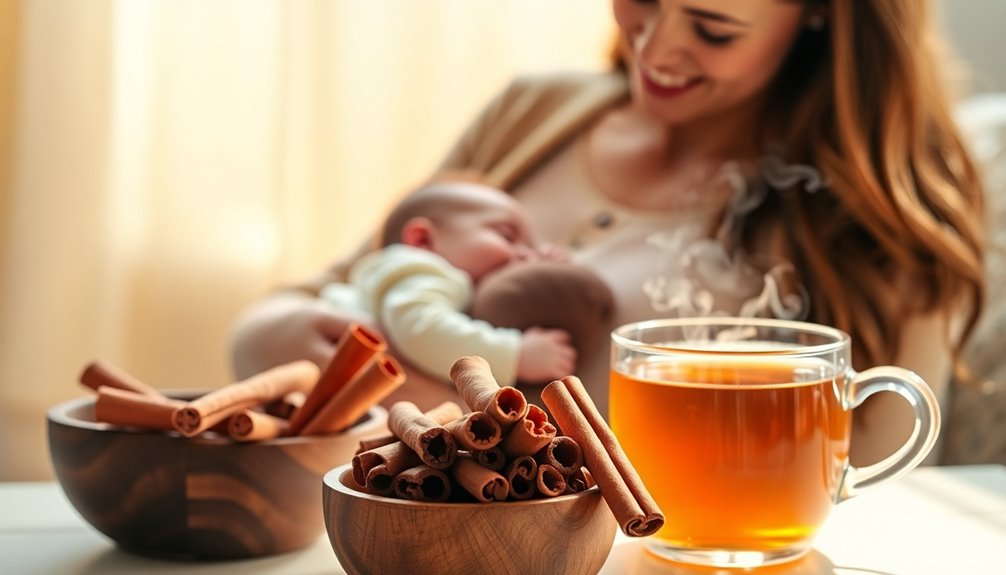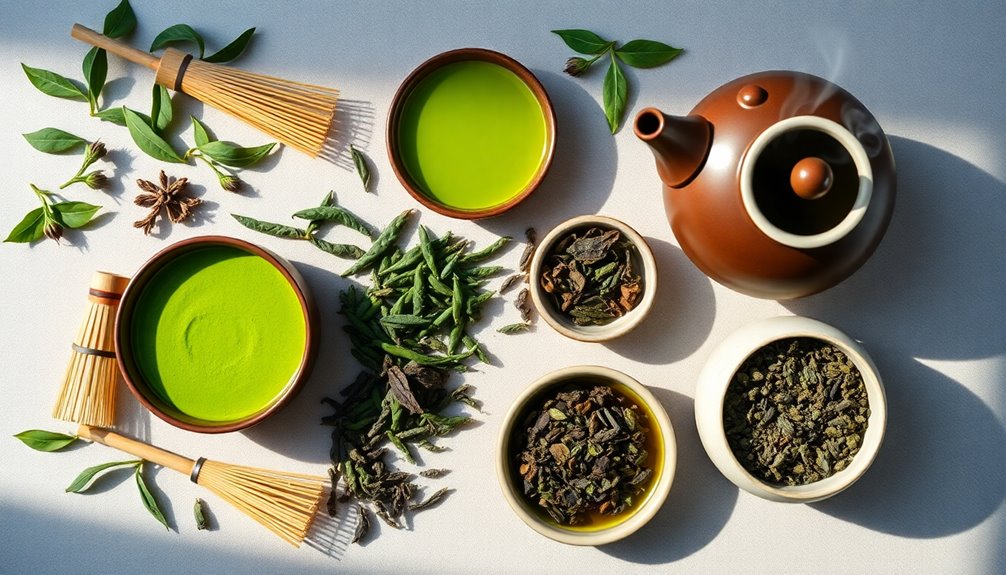You can cool your tea without ice while keeping its flavor intact. Pour your hot tea between two containers to enhance air exposure and cool it in under a minute. Immersing the tea container in cold water for 2-4 minutes is another effective method. You can also use a Cool Twister for a rapid chill in less than 90 seconds. If you want to maintain balance, consider diluting concentrated tea with cool water. Stirring your tea increases surface area and enables faster cooling. Keep going to discover more techniques that can enhance your chilling process.
Key Takeaways
- Pouring tea between two containers enhances air exposure, cooling it quickly without dilution.
- Immerse the tea pan in cold water for 2-4 minutes to reduce temperature while preserving flavor.
- Use a Cool Twister to lower the tea temperature rapidly in under 90 seconds.
- Stirring the tea increases surface area, promoting faster heat exchange with the air.
- Dilute concentrated tea infusion with cool water for precise temperature adjustments without altering flavor significantly.
Methods for Cooling Tea
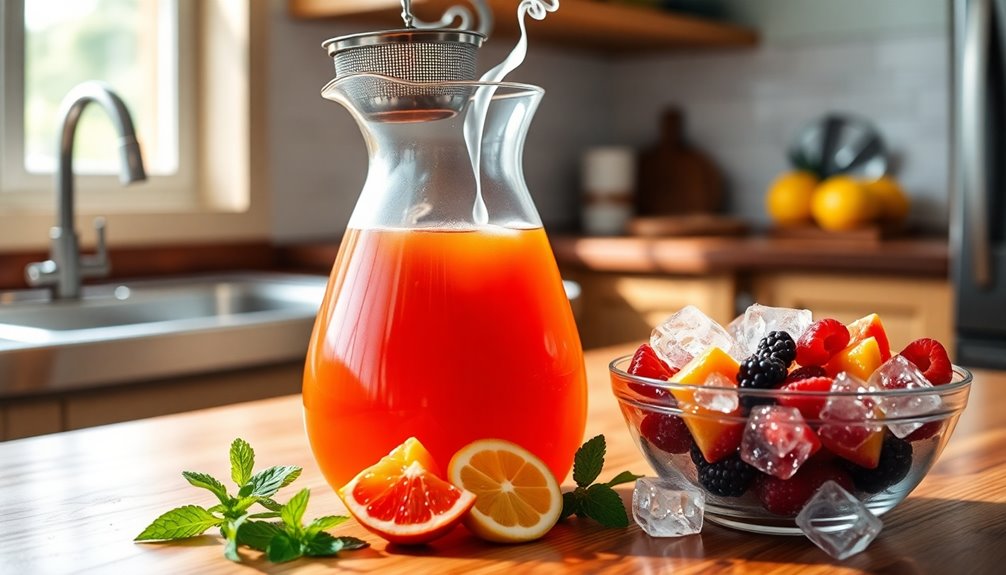
When you're keen to enjoy your hot tea but can't stand the heat, there are several effective methods to cool it down quickly.
One simple way is to pour the tea between two containers. This increases air exposure, allowing it to cool in under a minute without altering the flavor.
Alternatively, immerse your tea pan in cold water for 2-4 minutes; this method also effectively reduces the temperature while preserving taste.
If you have a Cool Twister, use it to lower the temperature in less than 90 seconds.
Finally, consider making a concentrated infusion and then diluting it with cool water for precise temperature adjustments.
Pouring the tea from a height enhances surface area exposure, facilitating faster cooling.
Cooling Agents to Consider
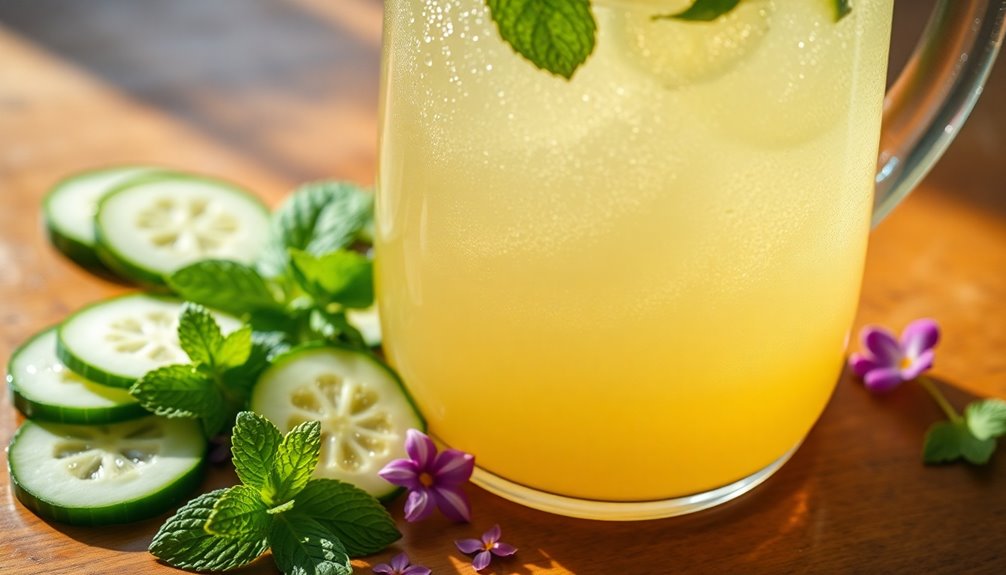
After exploring effective methods to cool your tea, it's time to reflect on cooling agents that can enhance the process. Here are some options to evaluate:
| Cooling Agent | Benefits |
|---|---|
| Cool Water | Helps achieve desired temperature without much flavor alteration. |
| Immersing in Cold Water | Maintains flavor profile while cooling effectively in 2-4 minutes. |
| Metal Spoon | Increases air exposure and cools faster by absorbing heat. |
| Pouring Between Containers | Enhances air exposure, facilitating faster cooling without dilution. |
| Cool Twister | Rapidly reduces tea temperature in under 90 seconds. |
Experiment with these cooling agents after you remove from heat, and enjoy your perfectly cooled tea while preserving its unique flavor profile! Additionally, consider that herbal tea can be a delightful option for cooling while providing health benefits.
Heat Transfer Principles
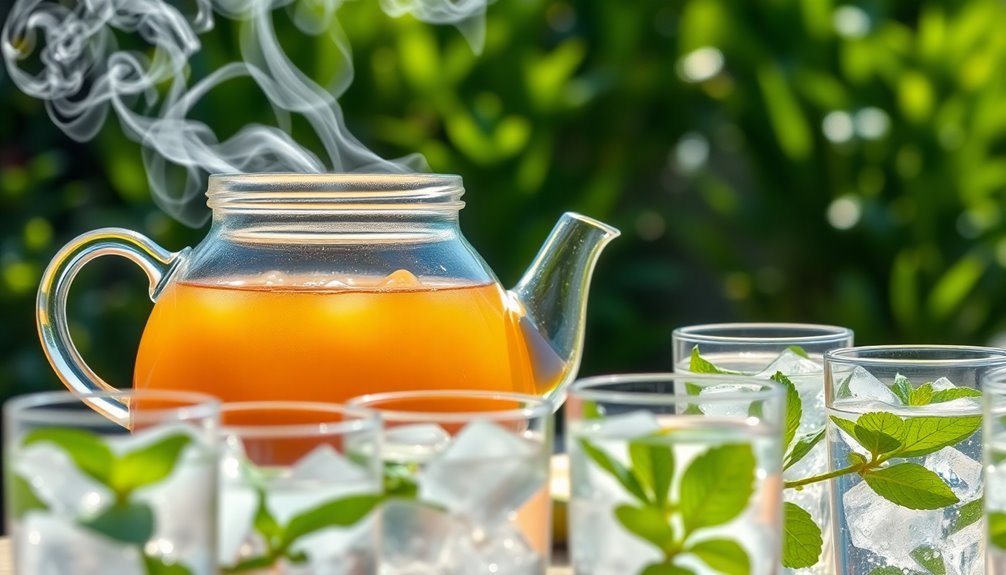
Understanding heat transfer principles is vital for effectively cooling your tea without ice.
Heat transfer occurs when your hot tea encounters a cold fluid, allowing the cold fluid to absorb heat and lower the tea's temperature. The greater the temperature difference between the two, the faster the cooling happens.
Specific heat capacity plays an important role, as it determines how much heat the cold fluid can absorb before its own temperature rises considerably.
To boost cooling efficiency, stir your tea; this increases the surface area exposed to the air, enhancing heat exchange.
You can also calculate the final temperature of your mixture using weighted averages, which helps you achieve precise control over the resulting temperature.
Practical Cooling Techniques

Cooling your tea quickly and effectively can be achieved with some practical techniques that enhance heat transfer. Here are some cooling techniques you can try:
| Technique | Description |
|---|---|
| Pouring Between Containers | Increases air exposure, cooling tea in under a minute. |
| Cold Water Immersion | Place the tea pan in cold water for 2-4 minutes. |
| Cool Twister | Rapidly lowers temperature in under 90 seconds. |
| Concentrated Infusion | Make a concentrated tea infusion, then dilute with cool water for precise temperature control and flavor preservation. |
Additionally, pouring tea from a height increases surface area for air exposure, facilitating faster cooling. Experiment with these methods to find what works best for you!
Cultural Influences on Tea Cooling

While tea cooling methods vary around the world, they often reflect the unique cultural practices and values of each region.
In India, chai vendors cool tea by pouring it back and forth between containers, creating a frothy texture while lowering the temperature.
Japanese tea ceremonies emphasize serving tea at the perfect infusion temperature, often using shallow bowls for cooling.
In Moroccan tea culture, mint tea is traditionally poured from a height, enhancing aeration and cooling without ice.
Similarly, the Chinese employ a "tea cooler" to rapidly reduce temperature while preserving flavor.
Many cultures also use pre-cooled or room temperature water to achieve a lower infusion temperature, ensuring a revitalizing tea experience without direct ice contact. Moreover, like coffee consumption(#) in different cultures, these practices showcase how local customs shape beverage preparation and enjoyment.
Brewing Kombucha Basics

If you're looking to explore new ways to enjoy tea, brewing kombucha can be a revitalizing choice. Start by sourcing a SCOBY, which you can get from other brewers or online. Next, brew sweetened tea using black, green, white, or oolong tea types. It's important to cool the sweetened tea to room temperature before adding the SCOBY and starter kombucha to initiate the fermentation process. This process benefits from the presence of certain antioxidants, which enhance the nutritional value of the final beverage.
Here's a quick overview:
| Step | Action | Notes |
|---|---|---|
| 1. Source SCOBY | Obtain from friends or online | Essential for brewing |
| 2. Brew Tea | Use sweetened tea | Black, green, white, oolong |
| 3. Cool Tea | Let it cool to room temperature | Important before adding SCOBY |
| 4. Ferment | Wait about one week | Transform into kombucha |
Fermentation Process for Kombucha
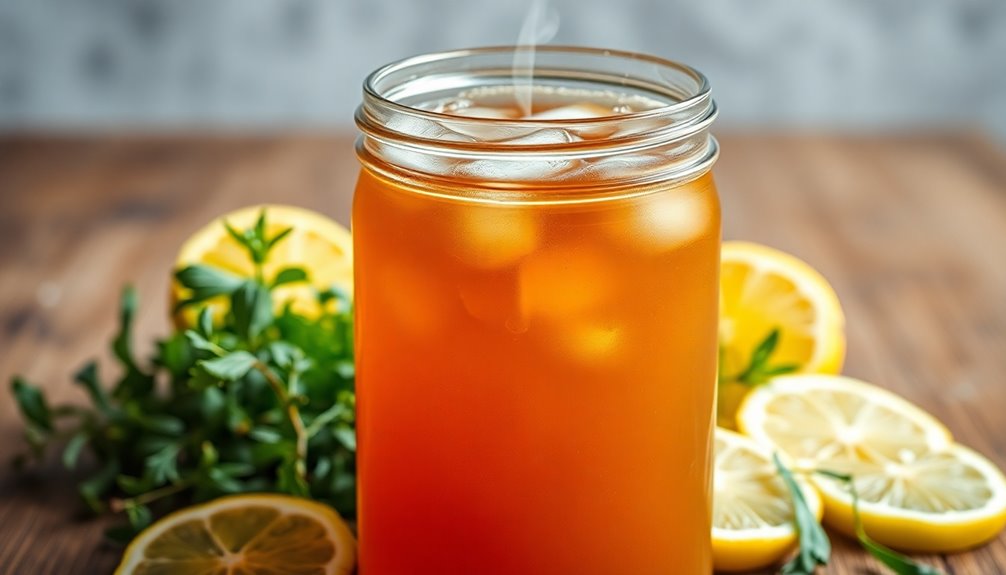
Understanding the fermentation process for kombucha is essential for creating a delicious, gut-friendly beverage.
You start by combining sweetened tea with a SCOBY and some starter tea, which kicks off the fermentation. At room temperature, typically between 75-85°F, your brew will ferment for about 7 to 14 days.
During this time, the yeast in the SCOBY consumes sugars, producing carbon dioxide that adds natural fizziness to your Kombucha Tea. The acidic environment formed helps keep harmful bacteria at bay while promoting beneficial probiotics. Additionally, the fermentation process can enhance the drink's health benefits, such as improved gut health, thanks to the presence of probiotics and organic acids.
Regularly tasting your brew is key, as it lets you monitor flavor development and decide when to bottle your kombucha for that perfect balance of sweetness and tartness.
Flavoring Your Kombucha

Flavoring your kombucha opens up a world of delicious possibilities.
You can add fruits like berries or citrus for a sweet twist, or herbs like mint for a revitalizing kick.
Each infusion creates a unique taste, so don't hesitate to experiment and find your perfect blend!
Fruit Infusions
Adding fruit to your kombucha not only enhances its flavor but also introduces a delightful sweetness that can transform your brew. To create delicious fruit infusions, add fresh or dried fruits, like berries or citrus, during the bottling process. Experiment with flavor combinations, pairing fruits with herbs like mint for an aromatic twist.
Allow your bottled kombucha to sit at room temperature for 1 to 3 days before you refrigerate it to stop kombucha fermentation. Monitor your infusion daily to check carbonation levels, ensuring your bottles withstand the pressure.
| Fruit | Flavor Combination | Ideal Infusion Time |
|---|---|---|
| Berries | Mint | 2-3 days |
| Citrus | Basil | 1-2 days |
| Apples | Ginger | 2-3 days |
Herbal Enhancements
While exploring new ways to elevate your kombucha, herbal enhancements can bring a revitalizing twist that tantalizes your taste buds.
You can infuse your brew with dried herbs like peppermint, ginger, or hibiscus during the second fermentation for unique flavors and added health benefits.
Stick to using dried herbs or fruits, as fresh ingredients might introduce unwanted bacteria. Add about 1-2 tablespoons of dried herbs or 1/4 cup of chopped fruits per quart of kombucha during bottling.
Let it ferment for an additional 1-3 days at room temperature to develop your flavor profile and carbonation.
Remember to monitor the taste daily to prevent over-carbonation and guarantee a perfectly balanced, infused kombucha experience.
Safety Tips for Brewing Kombucha

When brewing kombucha, keeping everything clean is essential for a successful batch. Regularly inspect your fermentation environment and the SCOBY for any signs of issues, like mold or off smells. Additionally, using user-friendly apps can help you track your brewing process and maintain optimal conditions.
Clean Equipment Regularly
- Use hot water and unscented soap for all brewing equipment, including your fermentation jar.
- Rinse your SCOBY and any tools with filtered water to keep harmful substances at bay.
- Cover fermentation jars with tightly woven cloths to prevent insects and dust while allowing air circulation.
- Store all equipment in a clean, dry area to minimize bacteria and mold growth.
- Regularly check for changes in scent or consistency in your brewing environment to ensure the health of your SCOBY.
Monitor Fermentation Environment
Keeping your brewing equipment clean sets the stage for a successful kombucha batch, but the fermentation environment plays an equally important role.
To guarantee ideal SCOBY activity, maintain a temperature range of 75-85°F. Avoid exposing the fermentation jar to direct sunlight, as UV light can harm the SCOBY. Instead, use a tightly woven cloth to cover the jar, allowing airflow while keeping contaminants out.
Regularly check for any signs of mold or off-putting odors, as these may indicate contamination and necessitate discarding the batch.
When preparing your tea, make sure to let it cool after bringing water to a boil, and always handle the SCOBY with clean equipment and hands to minimize harmful bacteria risks. Additionally, ensure that the brewing area has good airflow as it can help in maintaining a healthy fermentation process.
Inspect SCOBY for Issues
Inspecting your SCOBY for issues is essential for a successful kombucha brew, as even minor problems can lead to contamination. Here are some key points to watch for:
- Fuzzy black or green spots indicate mold and necessitate disposal.
- A healthy SCOBY can float at various levels, but holes or excessive thickness might mean it needs trimming or discarding.
- If the aroma shifts to a strongly vinegary scent, it may signal over-fermentation, prompting a review of your fermentation duration.
- Always maintain cleanliness by using clean hands and sanitized utensils to prevent contamination.
- Additionally, be aware that cleanliness in brewing is crucial to avoid unwanted bacteria that could spoil your kombucha.
Frequently Asked Questions
How Do You Cool Down Tea Without Ice?
To cool down your tea without ice, try pouring it back and forth between two containers. This exposes the tea to more air, speeding up the cooling process.
You can also immerse the tea container in cold water for a couple of minutes.
If you're in a hurry, consider stirring a metal spoon in the tea; it absorbs heat quickly.
Each method lets you enjoy your tea at a perfect temperature without diluting its flavor.
How to Cool Tea for Kombucha?
Did you know that fermentation occurs best between 75-85°F?
To cool your tea for kombucha, steep it in hot water and let it sit until it reaches that ideal temperature. Once cooled, you can add the sugar to the tea, ensuring it dissolves completely before introducing the SCOBY. If you’re feeling adventurous, you can experiment with making kombucha without tea by using alternative herbal infusions; just be mindful of the fermentation process and how it may differ from traditional tea-based kombucha. Remember, the key to a successful brew is maintaining the right balance of sweetness and acidity, regardless of the base you choose.
You can also pour it back and forth between two containers to speed up the cooling process.
Alternatively, immerse the pan in cold water for a few minutes.
These methods keep your tea's flavor intact, making it perfect for brewing.
How Do You Make Cold Tea Without Ice?
To make cold tea without ice, you can pour hot tea between containers to increase air exposure, allowing it to cool quickly.
Alternatively, place your tea in a shallow pan and immerse it in cold water for 2-4 minutes.
If you mix cool water into your hot tea, do so carefully to maintain flavor balance.
For a speedy option, consider using a Cool Twister, which can cool your tea in under 90 seconds.
How to Cool Tea for Iced Tea?
You've brewed a lovely pot of tea, but it's too hot to enjoy just yet.
To cool it down for iced tea, try pouring it back and forth between two containers. This method invites air to mingle, speeding up the cooling process.
Alternatively, immerse the tea pan in cold water for a few minutes. Stirring with metal spoons can also help.
Soon, you'll savor that revitalizing iced tea without losing any flavor!
Conclusion
Cooling your tea without ice can be as invigorating as a gentle summer breeze. By using techniques like cold brewing or incorporating cooling agents, you can enjoy your drink at the perfect temperature. Remember to reflect on the principles of heat transfer and embrace cultural methods for cooling. If you're brewing kombucha, follow the basics and safety tips to guarantee a delicious result. Cheers to enjoying your tea just the way you like it!

